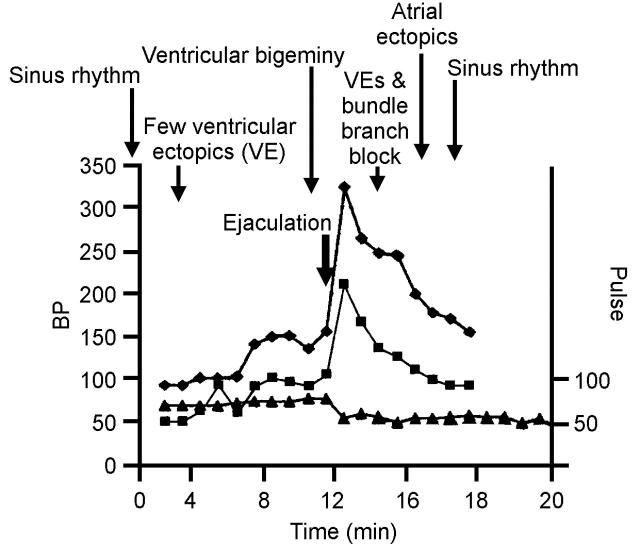Autonomic dysreflexia, with cardiovascular manifestations, is commonly seen in patients with spinal cord injury above the level of C6.
CASE HISTORY
A man of 54 sought advice because of erectile dysfunction. At age 17 he had sustained a C6 fracture resulting in quadriplegia. Over several years he regained 4/5 power in his arms and was able to walk with the assistance of two crutches, power 4/5 in his legs. He had been married for 30 years, with a full sex life until 3 years previously, since when only partial erections had been obtained. He gave a history of severe pounding headaches at the moment of ejaculation. Autonomic spinal cord dysreflexia was suspected, and the response to sexual stimulation was assessed under carefully controlled private conditions with a consultant cardiologist present in an adjacent room. The electrocardiogram and blood pressure were monitored continuously. Resting blood pressure was 93/50 mmHg, heart rate 68/min. He then had sexual stimulation with his wife leading to orgasm. During stimulation the blood pressure rose rapidly and at the point of ejaculation it was 325/210 mmHg, with electrocardiographic changes and heart rate 55/min. Over the next seven minutes the blood pressure fell to 155/90 mmHg, with little change in heart rate (Figure 1).
Figure 1.
Blood pressure, heart rate and electrocardiographic changes during sexual stimulation. Blood pressure was measured with a Finapres monitor. ⋄=Systolic; ▪=diastolic; ▴=heart rate
COMMENT
Autonomic dysreflexia is seen in patients with spinal cord injury above the upper level of sympathetic outflow (C6).1 It can be precipitated by various stimuli including bowel or bladder distension and urinary tract infection. The main objective sign is a huge increase in systolic and diastolic blood pressure.2–4 In able-bodied individuals such a rise in blood pressure would be prevented by baroreceptor-induced vasodilatation and slowing of the heart rate. However, in these spinal cord injured patients, where the connection between the baroreceptor and the rest of the body is broken, the only way to counteract the hypertension is vasodilatation above the lesion level and a baroreceptor mediated decrease in heart rate. This vasodilatation above the lesion explains the flushing, sweating and pounding headache often associated with the syndrome. Since patients with high-level spinal cord injury are usually hypotensive, the high blood pressures that develop during autonomic dysreflexia represent changes of a magnitude that may cause cerebral vascular accidents and death.
The patient had longstanding late cycle atrial and ventricular ectopics. The latter became frequent, with transient ventricular bigeminy, when the blood pressure rose sharply, probably because of a reflex increase in vagal activity (as evidenced by the fall in heart rate). The transient bundle branch block may have resulted from sharply increased afterload on the left ventricle. Thus patients with underlying ischaemic heart disease may be at cardiac as well as cerebral risk during these episodes.
Therapeutic measures to prevent this haemodynamic instability have included the use of oral nifedipine5 and intravenous infusions of prostaglandin E2.6 Our patient had been initially keen to use sildenafil for treatment of his erectile dysfunction. There is some evidence that, in patients with multiple system atrophy, sildenafil can exacerbate hypotension; thus it might in theory help to prevent autonomic dysreflexia.7 However, having considered the possible catastrophic sequelae of further episodes of autonomic dysreflexia, our patient decided to abstain from further sexual activity.
References
- 1.Mathias CJ, Frankel HL. Autonomic disturbances in spinal cord lesions. In: Mathias CJ, Bannister R, eds. Autonomic Failure: A Textbook of Clinical Disorders of the Autonomic Nervous System. Oxford: Oxford University Press, 1999: 494-513
- 2.Kewalramani LS. Autonomic dysreflexia in traumatic myelopathy. Am J Phys Med 1980;59: 1-21 [PubMed] [Google Scholar]
- 3.Lindan R, Joiner E, Freehafer AA, Hazel C. Incidence and clinical features of autonomic dysreflexia in patients with spinal cord injury. Paraplegia 1980;18: 285-92 [DOI] [PubMed] [Google Scholar]
- 4.Kurnick N. Autonomic hyperreflexia and its control in patients with spinal cord lesions. Ann Intern Med 1956;44: 678-85 [DOI] [PubMed] [Google Scholar]
- 5.Steinberger RE, Ohl DA, Bennett CJ, McCabe M, Wang SL. Nifedipine pretreatment for autonomic dysreflexia during electroejaculation. J Urol 1990;36: 228-31 [DOI] [PubMed] [Google Scholar]
- 6.Frankel HL, Mathias CJ. Severe hypertension in patients with high spinal cord lesions undergoing electroejaculation: management with prostaglandin E2. Paraplegia 1980;18: 293-9 [DOI] [PubMed] [Google Scholar]
- 7.Hussain IF, Brady CM, Swinn MJ, Mathias CJ, Fowler CJ. Treatment of erectile dysfunction with sildenafil citrate (Viagra) in parkinsonism due to Parkinson's disease or multiple system atrophy with observations on orthostatic hypotension. J Neurol Neurosurg Psychiatry 2001;71: 371-4 [DOI] [PMC free article] [PubMed] [Google Scholar]



